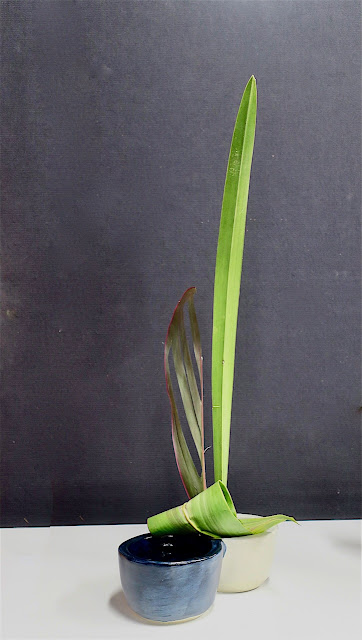The students each made two ikebana arrangements. The first was an upright form. Maureen brought attention to an orange-coloured fading New Zealand flax Phormium leaf by using a suiban with an orange interior.
Her second ikebana was a simple form using two single variegated Aspidistra leaves, that she partially shredded, in a pair of matching bottle shaped vases. The rhythm of the multiple lines seem to have a quite calming feeling.
Christine used a number of Elkhorn Platycerium fronds from her garden in her first ikebana. Because of their cascading nature she threaded the base of the leaves through the holes in a curled Monstera leaf, and then into a kenzan. A colour focus was achieved by using a single fading leaf that had a warm light-brown colouring.
In her second ikebana Christine used one fresh and three dried Bird's nest fern Asplenium nidus leaves. The dried leaves are especially hard to secure because the base of the stem invariably has a sharp "U" curve.
In her second ikebana Ellie focused on the colour and pattern variation on the surfaces of three leaves. The fourth leaf provides a counter movement to balance the other three leaves.
This week I was keen to use some of the Strelitzia juncea flowers in the garden before they were damaged by the rain.
The triangle of green lines is made from two stems with the minute leaf margins of this particular form of Strelitzia. I had previously created this triangular form as a mock-up for the recent exhibition of the Victorian Branch of the Sogetsu School. However, in the event, I did not use the idea as I did not have suitable flowers because the Strelitzia plant in the garden had not yet flowered. I have used five flowers in a vertically-tapering form that repeats the overall design. The two tallest flowers face forward and back respectively to achieve the tapering.
The vessel is a mid-20th century Japanese vase.
30th November 2024










No comments:
Post a Comment